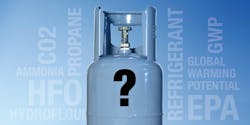What You Need to Know About the Refrigerant Transition
The author is the Principal Regulatory Compliance Engineer at Greenheck Group. This post originally appeared on the Greenheck blog.
The transition to low global-warming refrigerants in the HVAC/R industry has been making headlines as the EPA deadline for most HVAC/R products to conform to the new refrigerant regulation is January 1, 2025. The following provides the basics on refrigerants and the impacts of the new regulation.
What are refrigerants?
Refrigerants are fluids that move heat when using a difference in pressure. Naturally, heat moves from hot to cold, but when refrigerant is pushed with enough energy, heat can be moved from cold to hot. That’s fundamentally how refrigerators, air conditioners, and heat pumps work.
Why the transition to low global-warming refrigerants?
Hydrofluorocarbon chemicals (HFCs) have become one of the major greenhouse gas components in the earth’s atmosphere. For this reason, countries around the world have committed to reducing the global warming impact of hydrofluorocarbon (HFC) chemicals as part of the United Nations Kigali amendment. Since refrigerant leaks from HVAC/R equipment are a significant contributor to HFC emissions, the United States Environmental Protection Agency (EPA) has set regulations on the chemicals that can be used as refrigerants. As mentioned, the transition deadline to lower GWP refrigerants is January 1, 2025 for most HVAC/R products.
With the regulation of HFCs, what refrigerants can be used?
Carbon dioxide, ammonia, and propane can still be used as these natural refrigerants have relatively low Global Warming Potentials (GWPs). The industry has also developed a new class of refrigerants comprised of hydrogen, fluorine, and carbon known as hydrofluoroolefins (HFOs) that have lower GWPs as well. Not all HFCs have been banned as refrigerants as part of this regulation. HFC refrigerants and blends like R-32 and R-454B can be used as they have GWPs below the regulated levels.
What are the safety considerations with these refrigerants?
Outside of carbon dioxide, the aforementioned refrigerant types are either toxic, flammable, or both. To address these safety concerns, ASHRAE has a classification system to explain the safety considerations needed for each refrigerant. For example, R-32 and R-454B have a safety classification of A2L which means they are refrigerants with lower toxicity and lower flammability hazards. Safety standards and codes use these classifications to set limits on how much refrigerant can be used and the measures that need to be in place for safe operation. A great deal of testing has been done by different organizations to make sure that these limits and safety measures properly protect people and buildings.
How are refrigerant regulations changing?
The EPA has multiple regulations that need to work together to minimize the global warming impact of HFC refrigerants. These regulations also need new product safety standards and modified local building codes to address hazards effectively. While the regulations and product safety standards are in place, many states still need to adopt or amend their codes to match the latest model building codes for this transition to work well for the building industry.
Many states are actively engaged in developing climate action plans which include addressing refrigerants. Twelve states from the US Climate Alliance have developed their own refrigerant regulations that adopted earlier EPA guidance. While many regulations are closely aligned today, future phasedown requirements as part of the Kilgali Amendment may cause deviations between these regulatory agencies.
For the most up-to-date refrigerant transition information, refer to the following sources:
- Air Conditioning, Heating & Refrigeration Institute (AHRI) https://www.ahrinet.org/advocacy/safe-refrigerant-transition
- Environmental Protection Agency (EPA) https://www.epa.gov/climate-hfcs-reduction
About the Author
Eric Erdman
Based in Schofield WI, Erdman is Principal Regulatory Compliance Engineer at Greenheck Group. He joined Greenheck in 2006 after graduating from the University of Wisconsin-Platteville with a B.S. in Engineering Physics. Since then, Erdman has served as a product development engineer, a principal engineer, and a controls engineering manager before assuming his current role.
